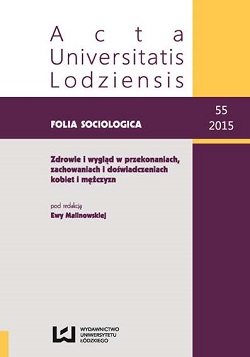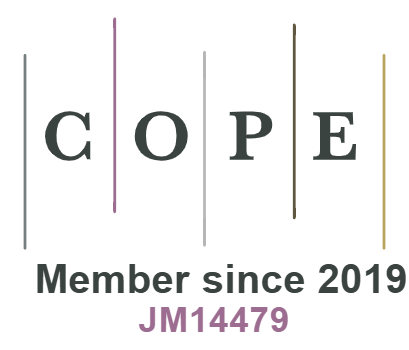Ocena własnego ciała oraz stanu zdrowia u osób transseksualnych
DOI:
https://doi.org/10.18778/0208-600X.55.07Słowa kluczowe:
identyfikacja płciowa, transseksualizm, korekta płci, cielesność, zdrowie, healthAbstrakt
Transseksualizm definiowany jest jako zakłócenie identyfikacji płciowej, które polega na rozbieżności między psychicznym poczuciem przynależności do danej płci a biologiczną budową ciała, płcią metrykalną, socjalną oraz prawną. Ponieważ nie istnieje metoda, która pozwoliłaby na dopasowanie identyfikacji płciowej do ciała człowieka, oddziaływanie leczniczo-terapeutyczne koncentruje się na odwrotnym zabiegu: dostosowuje cielesność do wykazywanej tożsamości płciowej. Wskazuje się, że osoby transseksualne są więźniami własnych ciał – transseksualni mężczyźni cierpią w ciele kobiecym, transseksualne kobiety – w ciele męskim, co niejednokrotnie wiąże się z odrzuceniem swojego ciała, niechęcią do niego, awersją do zewnętrznych narządów płciowych. Proces korekty płci przebiega wielopłaszczyznowo, obejmując wieloaspektową diagnostykę, prawną zmianę danych osobowych, kurację hormonalną oraz zabiegi operacyjne. Osoby transseksualne są narażone na wiele skutków ubocznych kuracji hormonalnych oraz komplikacji pooperacyjnych. Wskazuje się również, że medyczny proces korekty płci skraca czas przeżycia od kilkunastu do kilkudziesięciu lat. W niniejszym artykule zostanie przedstawiona tematyka cielesności oraz stanu zdrowia osób transseksualnych. Autor dokona analizy odpowiedzi dotyczących oceny własnego ciała oraz stanu zdrowia udzielonych przez 16 osób transseksualnych, które wzięły udział w badaniu. Analizy są początkiem szerzej zakrojonych badań nad różnorodnymi aspektami zaburzeń tożsamości płciowej.
Bibliografia
Antoszewski B., Żądzińska E. (2008), The Metric Features of Teeth in Female-to-Male Transsexuals, ,,Archives of Sexual Behavior”, Vol. 38, s. 351–358.
Google Scholar
DOI: https://doi.org/10.1007/s10508-008-9315-3
Chiland C., Clouet A.-M., Golse B., Guinot M., Wolf J. P. (2013), A new type of family: Transman as fathers thanks to donor sperm insemination. A 12-year follow-up exploratory study of their children, ,,Neuropsychiatrie de l’enfance et de l’adolescence”, Vol. 61, s. 365–370.
Google Scholar
DOI: https://doi.org/10.1016/j.neurenf.2013.07.001
Cohen-Kettenis P. T., Gooren L. J. G. (1999), Transsexualism: a review of etiology, diagnosis and treatment, ,,Journal of Psychosomatic Research”, Vol. 46, No. 4, s. 315–333.
Google Scholar
DOI: https://doi.org/10.1016/S0022-3999(98)00085-3
Czarnecka A. (2003), Czy mózg ma płeć? Różnice w budowie ludzkiego mózgu, ,,Kosmos. Problemy Nauk Biologicznych”, T. 52, nr 1, s. 21–27.
Google Scholar
Dulko S. (2008), Modele partnerstwa i relacji małżeńskich transseksualistów typu kobieta-mężczyzna i mężczyzna-kobieta, ,,Przegląd Seksuologiczny”, nr 16, s. 5–11.
Google Scholar
Dziemian A., Łucka I. (2008), Transseksualizm czy zinternalizowana homofobia – studium przypadku, ,,Psychiatria Polska”, T. 42, nr 1, s. 105–114.
Google Scholar
Green R., Young R. (2001), Hand Preference, Sexual Preference and Transsexualism, ,,Archives of Sexual Behavior”, Vol. 30, No. 6, s. 565–574.
Google Scholar
DOI: https://doi.org/10.1023/A:1011908532367
Imieliński K., Dulko S. (1988), Przekleństwo Androgyne. Transseksualizm: mity i rzeczywistość, Wydawnictwo Naukowe PWN, Warszawa.
Google Scholar
Imieliński K., Dulko S. (2001), Przekleństwo Androgyne, Wydawnictwo ARC-EN-CIEL, Kraków.
Google Scholar
Pużyński S., Wciórka J. (2000), Klasyfikacja zaburzeń psychicznych i zaburzeń zachowania ICD-10, Uniwersyteckie Wydawnictwo Medyczne ,,Vesalius”, Kraków.
Google Scholar
Kula K., Słowikowska-Hilczer J. (2003), Kliniczne znaczenie badań nad różnicowaniem i dymorfizmem płciowym mózgu, ,,Psychiatria w Praktyce Ogólnolekarskiej” nr 3(1), s. 7–16.
Google Scholar
Kula K., Słowikowska-Hilczer J. (2012), Zaburzenia determinacji i różnicowania płci, [w:] A. Szczeklik (red.), Choroby wewnętrzne. Stan wiedzy na rok 2012, Wydawnictwo Medycyna Praktyczna, Kraków.
Google Scholar
Malinowski A., Maciołek Blewniewska G. (2007), Dlaczego histerektomia pochwowa?, ,,Ginekologia Polska”, T. 78, nr 6, s. 434–442.
Google Scholar
Mandal E. (2003), Kobiecość i męskość, Wydawnictwo Akademickie Żak, Warszawa.
Google Scholar
Matusiak-Kita M., Zdrojewicz Z. (2009), Orgazm po zabiegach ginekologiczno-urologicznych, ,,Przegląd Seksuologiczny”, nr 19, s. 5–9.
Google Scholar
Nowosielski K. (2010), Identyfikacja i rola płciowa, [w:] Z. Lew-Starowicz, V. Skrzypulec (red.), Podstawy seksuologii, PZWL, Warszawa.
Google Scholar
Pankowska D. (2005), Wychowanie a role płciowe, Gdańskie Wydawnictwo Psychologiczne, Gdańsk.
Google Scholar
Rawa-Kochanowska A. (2011), Poczucie tożsamości płciowej w teorii i badaniach, Difin, Warszawa.
Google Scholar
Seligman M. E. P., Walker E. F., Rosenhan D. L. (2003), Psychopatologia, Zysk i S-ka, Poznań.
Google Scholar
Strzelecka A., Kozera P. (2007), Płeć pomylono, ,,Charaktery”, nr 3, s. 66 – 69.
Google Scholar
Urban M. (2009), Transseksualizm czy urojenia zmiany płci? Uniknąć błędnej diagnozy, ,,Psychiatria Polska”, T. 43, nr 6, s. 719–728.
Google Scholar
http://transhealth.vch.ca.
Google Scholar
http://www.staff.amu.edu.pl.
Google Scholar
http://www.gires.org.uk.
Google Scholar
http://www.healthnet.com.
Google Scholar
http://www.facialfeminizationsurgery.info.
Google Scholar
www.granicenauki.pl.
Google Scholar
Pobrania
Opublikowane
Jak cytować
Numer
Dział
Licencja
Prawa autorskie (c) 2015 © Copyright by Jonasz Wethacz, Łódź 2015; © Copyright for this edition by Uniwersytet Łódzki, Łódź 2015

Utwór dostępny jest na licencji Creative Commons Uznanie autorstwa – Użycie niekomercyjne – Bez utworów zależnych 4.0 Międzynarodowe.










